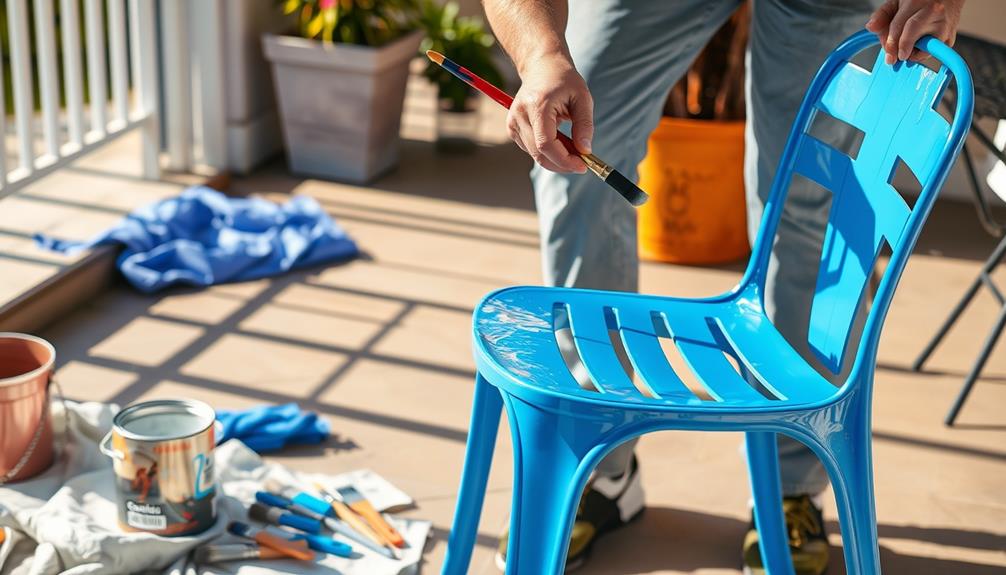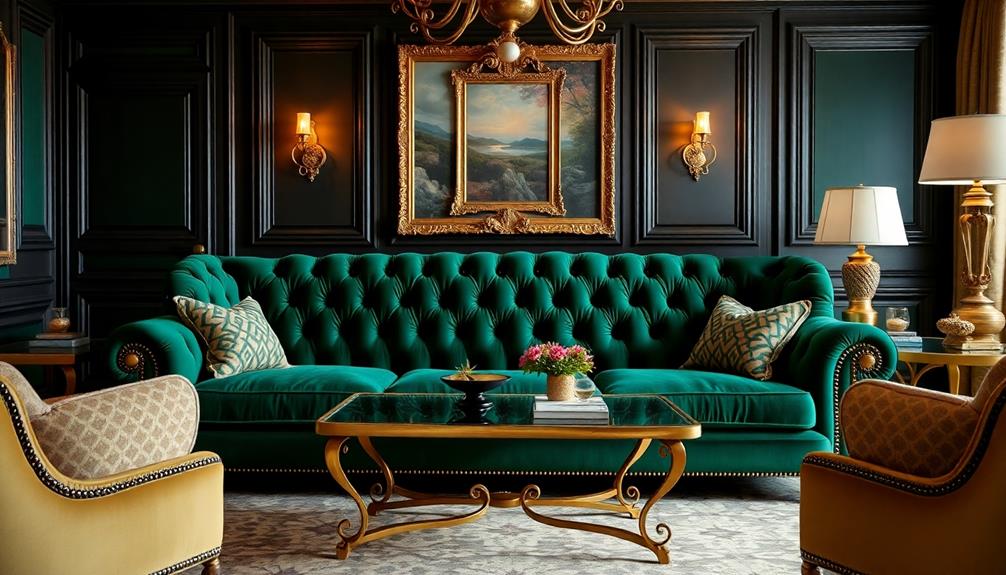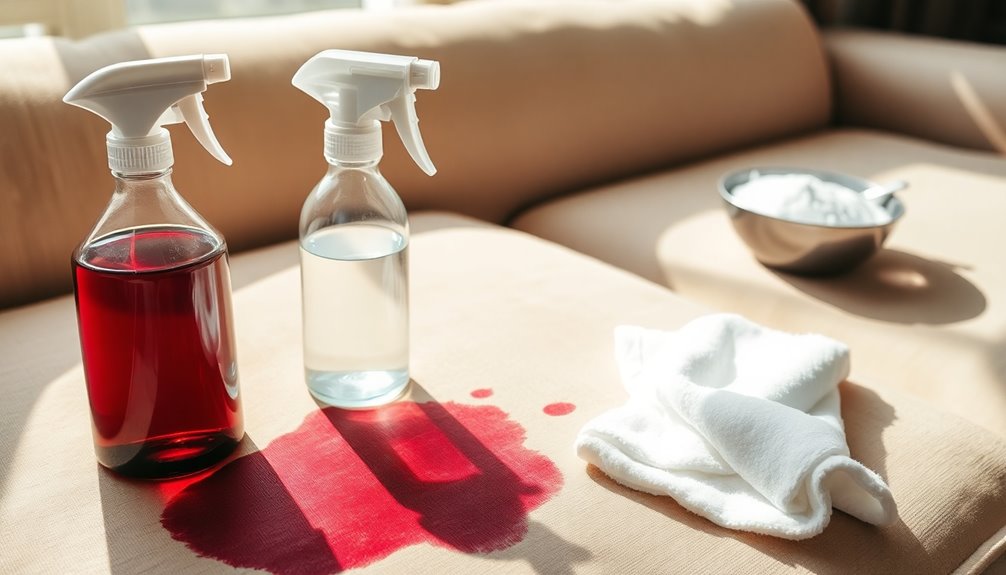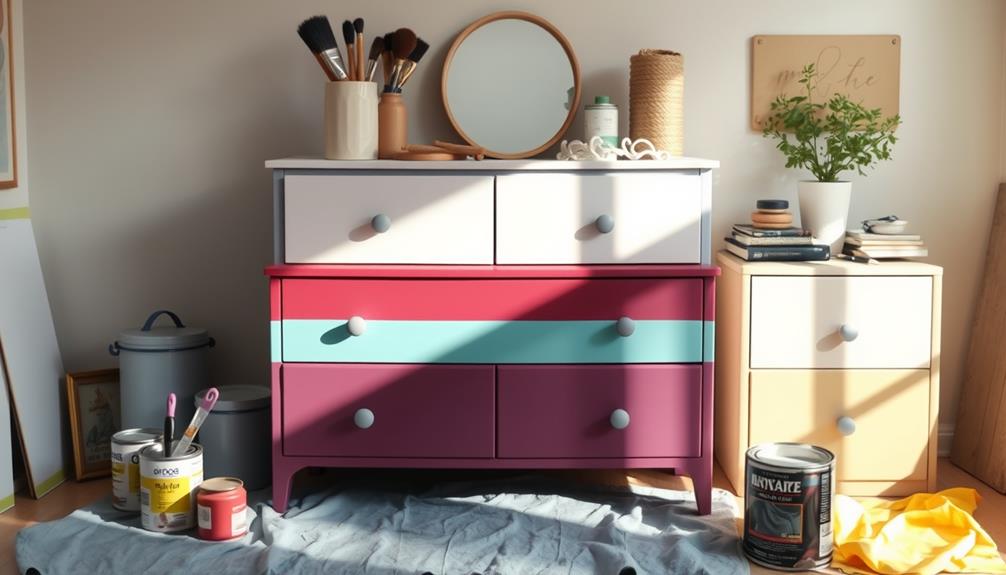When painting metal furniture, begin by cleaning the surface with a degreaser and sanding it to improve paint adhesion. Eliminate any rust and apply a rust-blocking primer. Once the primer has dried, select a high-quality paint designed specifically for metal, such as enamel or spray paint. Apply thin coats to ensure an even finish, allowing each coat to dry briefly in between. After painting, maintain your furniture by regularly cleaning it and touching up any chips. This simple project can completely transform your furniture, and there is a wealth of information available on techniques and tools to help your work stand out. Additionally, always work in a well-ventilated area and consider using a protective topcoat to increase durability and prevent damage from weather or daily use. Whether you are refreshing your metal furniture or tackling another DIY project like repainting wood furniture step by step, taking the time to properly prepare the surface and use the correct materials is essential for achieving professional results. With patience and attention to detail, you will achieve a long-lasting finish that enhances the appearance of your furniture.
Key Takeaways
- Clean and prep metal surfaces with a degreaser, sandpaper, and rust removal techniques for optimal paint adhesion.
- Use a rust-blocking primer before painting to enhance longevity and protect against rust.
- Select high-quality paint specifically for metal, such as enamel or spray paint, for best results.
- Apply paint in thin, even coats, allowing adequate drying time between each coat for a smooth finish.
- Maintain painted furniture with regular cleaning and prompt touch-ups to prevent rust and extend durability.
Benefits of Painting Metal Furniture
Painting metal furniture offers numerous benefits that can transform your living space. When you paint metal furniture, you breathe new life into old, rusty items, giving them a fresh and appealing look. This revitalization can greatly enhance the aesthetic of both indoor and outdoor spaces, making them feel more inviting.
Engaging in such creative projects can also help unleash your inner artist and rekindle your creativity, especially in a world saturated with screens and distractions, as discussed in the creative spark.
One of the standout advantages is the ability to customize your furniture. You can choose from a wide range of colors to match your decor and personal style, allowing your creativity to shine through. Plus, the process is often a quick DIY project that you can complete in under an hour, excluding drying time.
Using rust-inhibiting paint and primers is essential, as they protect metal surfaces from corrosion, greatly extending the lifespan of your furniture. This means your beautifully painted pieces won't only look great but also withstand the test of time.
Additionally, engaging in this creative endeavor can foster community involvement, as you might find inspiration from others sharing their makeovers during events like the Monthly Furniture Fixer Upper Day.
Preparation and Essential Tools
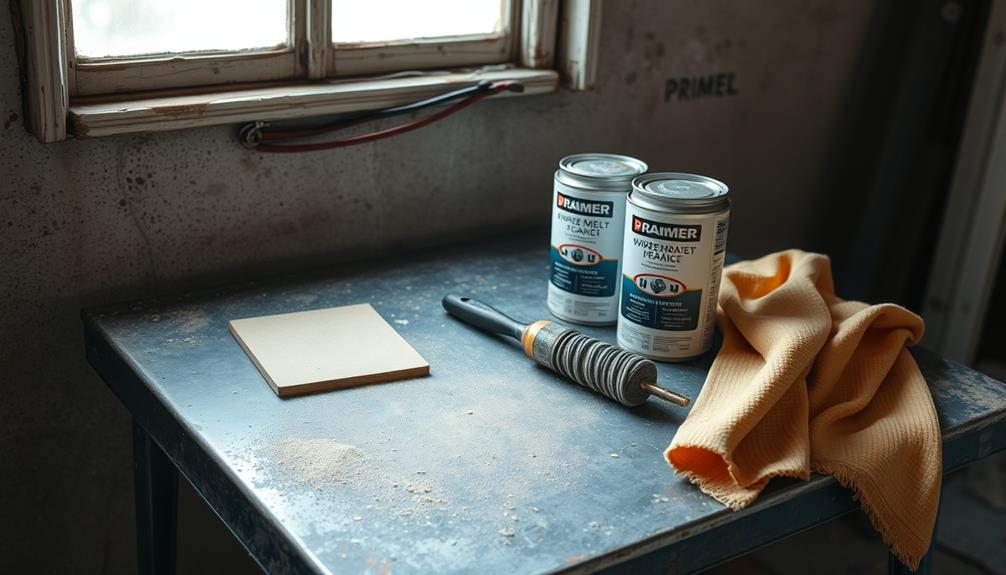
Getting your metal furniture ready for a fresh coat of paint involves careful preparation and the right tools. Start by thoroughly cleaning the metal surface with a degreaser to remove dirt, grease, and any loose rust. This step is essential for guaranteeing a smooth paint application.
Additionally, take into account the importance of using preventive maintenance plans to extend the life of your appliances, as a well-maintained surface can improve the outcome of your paint job.
Next, grab some sandpaper with a grit between 60-220 to roughen the metal surface, as this enhances paint adhesion.
If you spot any rust, use a wire brush and sponge to effectively remove it. For ferrous metals, you might even want to think about using a power washer for a deeper clean.
Once the surface is clean and prepped, it's time to apply a rust-blocking primer specifically designed for metal surfaces, such as Rust-Oleum Rust Performer. This primer will boost the durability of your paint job.
Additionally, make sure your workspace is well-ventilated to avoid inhaling fumes during the preparation and painting process.
With these tools and steps in place, you're set to achieve a beautiful finish on your metal furniture.
Choosing the Right Paint
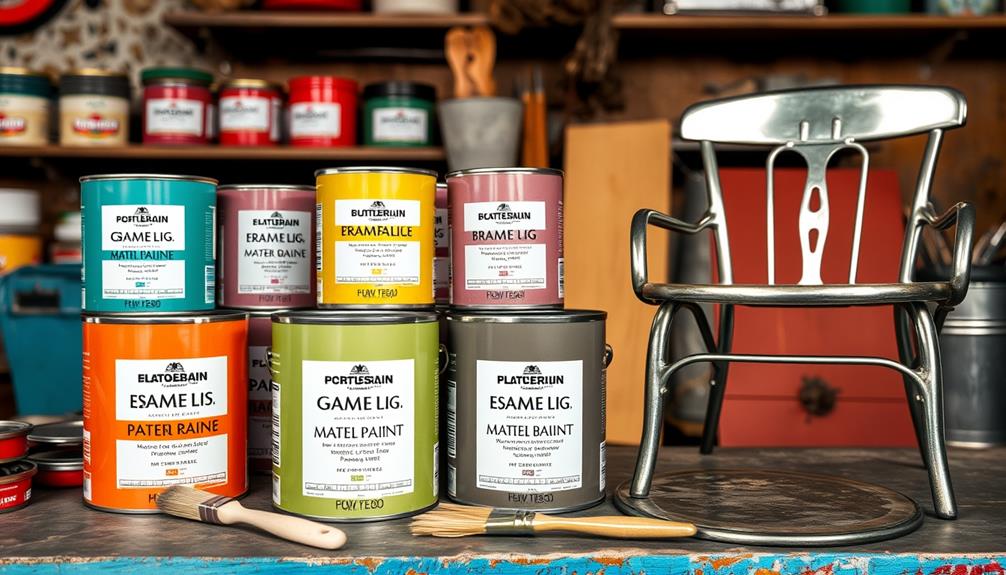
When you're choosing paint for your metal furniture, it's crucial to pick a type specifically made for metal surfaces, like enamel or spray paint.
Consider using an airless paint sprayer for a smooth finish and efficient application, especially if you're working on larger pieces.
Think about the colors and finishes that will complement your existing decor, ensuring you select options that suit your style.
By understanding the right paint types and color choices, you'll set yourself up for a successful project.
Paint Types Overview
Selecting the right paint for your metal furniture is essential for achieving a durable and attractive finish. When considering a paint types overview, you'll want to choose products specifically formulated for metal surfaces, like Rust-Oleum or Ultra Spec® HP D.T.M. Acrylic. These high-quality options provide rust resistance and long-lasting durability.
Spray paint specifically designed for metal is perfect for achieving even coverage, especially on intricate designs. If you're working on detailed areas or larger flat surfaces, brush-on paints can be a great choice. Look for oil-based spray paint specifically, as it tends to adhere better to metal.
Don't forget about primer and paint combos; these often include built-in primers that enhance adhesion, particularly on surfaces with rust or corrosion. You should also evaluate the available finish options, such as glossy, matte, or metallic, to find the best match for your decor.
Always check the manufacturer's instructions for ideal application conditions, including the recommended temperatures, generally between 50-90°F, and the drying times between coats to guarantee the best results for your metal furniture.
Color Selection Tips
Choosing the right color for your metal furniture can greatly enhance the overall aesthetic of your space. To guarantee a cohesive look, consider your existing decor and color scheme. Here are some essential color selection tips to guide you:
| Color Option | Best For | Finish Type |
|---|---|---|
| Neutral Tones | Versatile Spaces | Matte or Satin |
| Bold Colors | Statement Pieces | Glossy or Semi-Gloss |
| Earthy Hues | Outdoor Use | High-Quality Outdoor Paint |
| Metallic Finishes | Unique Touch | Metallic or Textured |
When painting, opt for colors with rust-inhibiting properties, especially those found in high-quality outdoor paints. These options enhance both durability and aesthetics. Metallic finishes like Gold Digger or Aged Copper can elevate your furniture's design.
Before diving in, test paint samples on a small area of your furniture to see how the color appears in different lighting conditions. Finally, choose a paint type suitable for metal surfaces, like enamel or acrylic, to guarantee longevity and proper adhesion. Happy painting!
Priming the Metal Surface
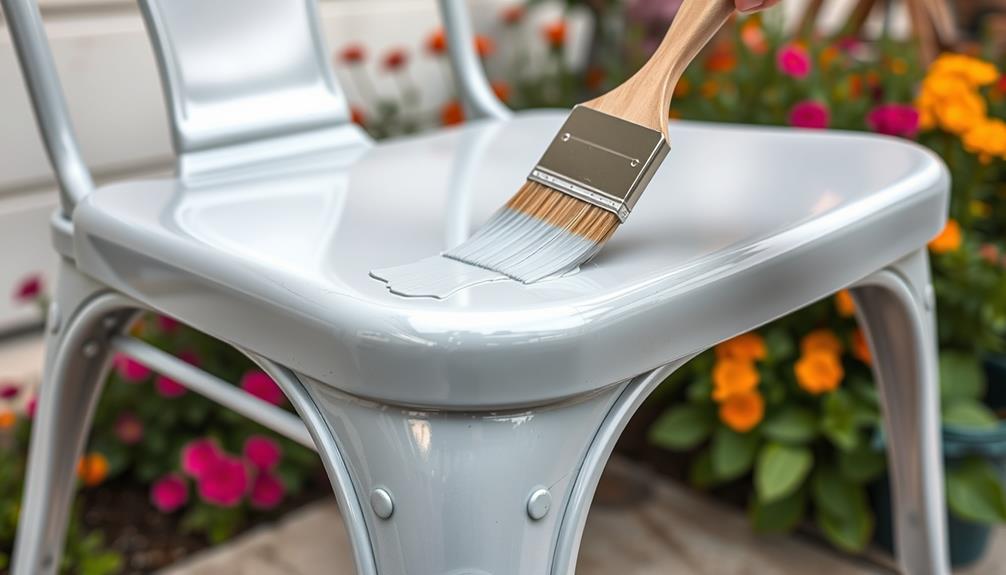
Properly priming the metal surface is essential for achieving a durable and attractive finish. Start by confirming the metal is thoroughly cleaned, removing any rust, grease, and dirt. This step is important for promoting better adhesion of the primer.
Use a high-quality rust-blocking primer, like Rust-Oleum Rust Performer, and apply it in thin, even coats. If the metal is heavily rusted, consider using multiple thin coats, allowing for adequate drying time between each application.
After the primer has dried completely—typically around 1-2 hours as per the manufacturer's instructions—take a moment to lightly sand the surface with 220-grit sandpaper. This will create a smooth surface for the paint and enhance adhesion between the primer and the topcoat.
Painting Techniques and Methods
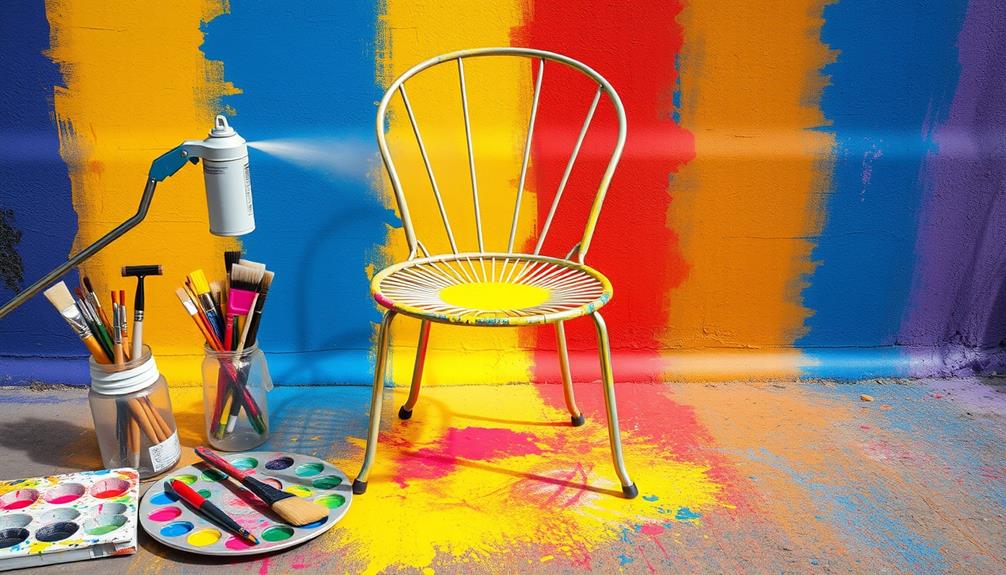
Once the metal surface is primed and ready, it's time to focus on painting techniques and methods that yield the best results. Here are some effective options to take into account:
- Spray Painting: Ideal for achieving a smooth finish quickly. Maintain a consistent distance from the surface and apply in light coats to avoid drips. Guarantee proper ventilation and wear a mask to stay safe.
- Brush Painting: For detailed areas, use high-quality small, flat brushes, especially in damp or humid conditions. This method allows for precision and control.
- Foam Rollers: Excellent for larger, flat surfaces, foam rollers can help you cover more area efficiently while still achieving a decent finish.
- Flexible Bristle Brushes: Use these for intricate designs and edges. Their long, flexible bristles help you navigate tight corners and detailed areas effortlessly.
Remember to wait about 5 minutes between coats to allow for adequate dry time and ideal adhesion.
Maintenance and Care
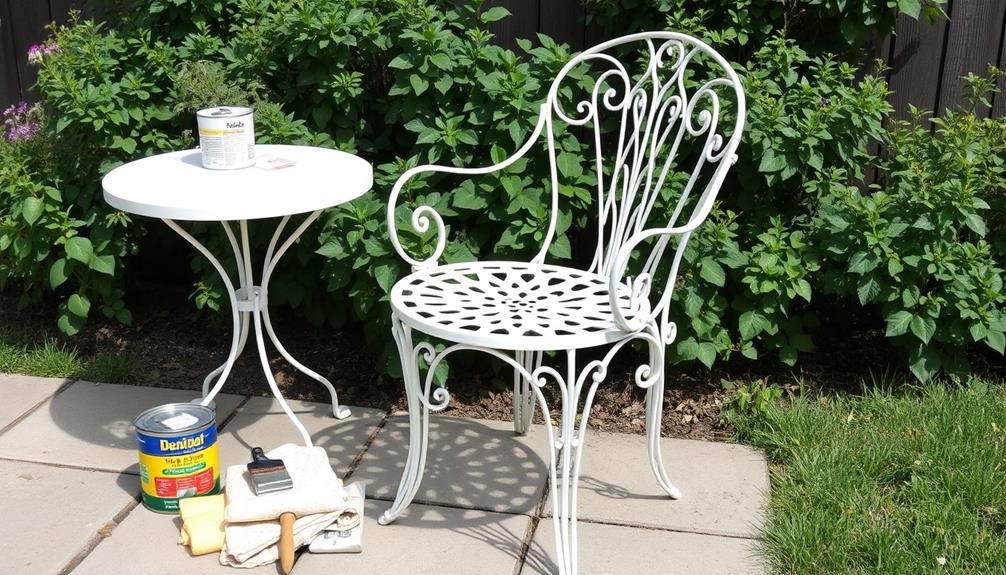
To keep your painted metal furniture looking great, you need to establish a regular cleaning routine.
Touching up any chips or scratches promptly will help prevent rust, and applying a protective coating every few years will enhance durability.
Let's explore these essential maintenance practices to guarantee your furniture stays in top condition.
Regular Cleaning Practices
While keeping your metal furniture looking its best may seem like a chore, regular cleaning practices can markedly enhance its longevity and appearance.
To maintain your painted surfaces and prevent rust, follow these essential steps:
- Use a Mild Soap Solution: Mix mild soap with water, and wipe down your furniture regularly. This helps remove dirt and grime without damaging the paint.
- Avoid Abrasive Cleaners: Steer clear of harsh chemicals or scrubbers. They can scratch the high-quality paint, leading to premature wear and potential rust.
- Inspect Painted Surfaces: Check your furniture at least once a month for any chips or scratches. Early detection allows for prompt touch-ups, which can prevent rust from developing.
- Reapply a Clear Coat: Every few years, use a paint brush to apply a high-quality clear coat. This adds an extra layer of protection against the elements, enhancing durability.
Touch-Up Techniques
Touching up your metal furniture is vital for maintaining its aesthetic and preventing rust. Regularly inspect your furniture for chips or scratches; timely touch-ups can greatly extend the life of the finish.
When it's time to touch up, use the same type of high-quality paint as the original application to guarantee color consistency and proper adhesion.
Start by cleaning the area to be touched up with mild soap and water. Allow it to dry completely before applying any paint. For small scratches, a fine brush or paint pen works best for precise application.
If you're dealing with larger areas, consider using a small roller or spray application for even coverage.
After you've completed the touch-ups, make certain to allow the paint to cure according to the manufacturer's instructions. This step is essential for achieving a durable and seamless finish.
Protective Coating Options
A variety of protective coating options can considerably enhance the longevity and appearance of your metal furniture.
Using a high-quality clear coat over the paint not only boosts durability but also gives a glossy finish that protects against chipping and fading.
To guarantee your furniture remains in top condition, consider these essential maintenance tips:
- Regular Maintenance: Clean painted surfaces with mild soap and water to maintain appearance and prevent dirt buildup.
- Annual Inspections: Check for signs of wear or rust each year. This allows you to reapply protective coatings as needed.
- Touch-Up Paint: Keep touch-up paint on hand for quick repairs on any chips or scratches, ensuring your furniture looks fresh.
- Proper Storage: Store your metal furniture indoors during extreme weather conditions to prolong its lifespan and reduce the need for frequent touch-ups or repainting.
Resources for DIY Projects
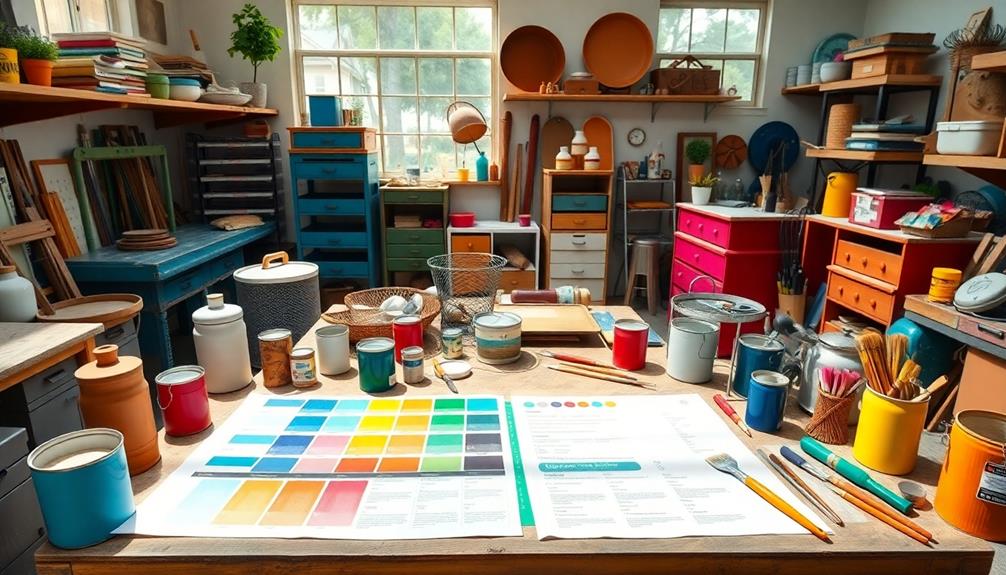
When diving into DIY projects like painting metal furniture, having the right resources can make all the difference. Start by accessing detailed step-by-step guides that cover everything from preparation to finishing touches. These guides help you understand the process better, guaranteeing your outdoor metal furniture looks stunning.
Video tutorials are another fantastic resource; they visually demonstrate painting techniques, making it easier for you to grasp the nuances of applying high-quality paint and metal primer.
Don't overlook community forums, where DIY enthusiasts share invaluable advice, inspiration, and tips on tackling rust and other challenges you might face.
You'll also want to refer to expert recommendations for high-quality paints and tools specifically designed for metal surfaces. These insights guarantee that your chosen supplies will yield successful results.
To streamline your project preparation, utilize online resources that compile essential supplies checklists, including safety gear and cleaning materials.
Frequently Asked Questions
What Kind of Paint Do You Use on Metal Furniture?
You should use paint specifically formulated for metal surfaces, like enamel or acrylic options. Look for rust-inhibiting properties, built-in primers, and consider spray paint for larger areas and brush-on for detailed work.
Do You Need to Sand Metal Furniture Before Painting?
You wouldn't want to paint over a shiny surface, right? Yes, you need to sand metal furniture before painting. It creates a rough texture, ensuring the paint adheres better and gives a smoother finish.
Do I Need to Prime Metal Before Painting With Rustoleum?
Yes, you need to prime metal before painting with Rust-Oleum, especially if it's rusted. A rust-blocking primer enhances adhesion and durability. If clean, you can use the paint and primer in one product.
How to Prep a Metal Table for Painting?
Imagine you've got an old metal table covered in rust. To prep it for painting, clean the surface, sand it down, check for damage, and protect surrounding areas with drop cloths and tape before you start.
Conclusion
Painting metal furniture can transform your space and give new life to old pieces. Remember, "a stitch in time saves nine"; taking the time to prep properly will pay off in the long run. With the right tools and techniques, you can achieve a professional-looking finish. Don't forget to maintain your newly painted furniture to keep it looking great for years to come. Get started on your DIY project today and enjoy the satisfaction of your handiwork! If you’re wondering *how to paint IKEA furniture*, the process is quite similar to painting other types of metal or wood furniture. Start by lightly sanding the surface to ensure the paint adheres properly, then apply a suitable primer before adding your chosen color. With careful attention to detail, you can easily rejuvenate affordable IKEA pieces and make them look custom-made!
